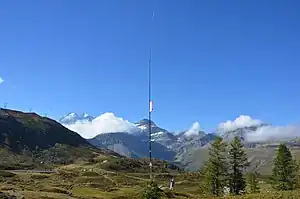
The 40-meter or 7-MHz band is an amateur radio frequency band, spanning 7.000-7.300 MHz in ITU Region 2, and 7.000-7.200 MHz in Regions 1 & 3. It is allocated to radio amateurs worldwide on a primary basis; however, only 7.000-7.200 MHz is exclusively allocated to amateur radio worldwide. Shortwave broadcasters and land mobile users also have primary allocations in some countries, and amateur stations must share the band with these users.
40-meters is considered one of the most reliable all-season long distance communication (DX) and intercontinental bands.
History
The 40-meter band was made available to amateurs in the United States by the Third National Radio Conference on October 10, 1924,[1] and allocated on a worldwide basis by the International Radiotelegraph Conference in Washington, D.C., on October 4, 1927.
For many years, the portion of the band from 7.100–7.300 MHz was allocated to short wave broadcast stations outside the Americas, and was not available to radio amateurs outside of ITU Region 2. At the World Radio Conference WRC-03 in 2003, it was agreed that the broadcast stations would move out of the section 7.100–7.200 MHz on 29 March 2009 and that portion would become a worldwide exclusive amateur allocation afterwards. Releasing the remaining 100 kHz of the band to amateurs at a later date is an IARU aim for future conferences.
Radio propagation characteristics
This band supports both long distance (DX) and intercontinental communications between late afternoon and a few hours after sunrise, and local-to-medium distance NVIS communication during most daylight hours.
With its unique combination of intracontinental and intercontinental communications possibilities, 40-meters is considered a key band in building a winning HF contesting score during any part of the sunspot cycle.
Usage
The band is most useful for long distance (DX) communications and intercontinental communication (ranges greater than 1,500 km or 1,000 miles) for one or two hours before sunset, during the night and for one or two hours after sunrise. It is extremely useful for local-to-medium distance communications out to a range of 600–1,500 km (400–1,000 miles) or more, depending on conditions, during the day. In higher latitudes, daytime intercontinental communication is also possible during the short days of winter, for example a good path often opens between Japan and northern Europe in the hours leading up to European midday from late November through late January, with a long path opening to the west coast of the United States and Canada after midday.
Due to the 24-hour nature of the band, the wide variety of ranges that can be spanned with it, and its shared nature, it tends to be extremely crowded, and interference from other amateurs and broadcasters often limits available and usable frequencies on this band.. In recent years amateurs in east and southeast Asia have also suffered severe interference from illegal users.
Band plans
In most jurisdictions the subdivision of the band into different operating modes is according to informal convention rather than legal requirement.
IARU Region 1
Europe, Africa, Middle East and Northern Asia[2]
| 40 meters | 7.000-7.040 | 7.040-7.050 | 7.050-7.060 | 7.060-7.200 |
|---|---|---|---|---|
| IARU Region 1 | ||||
IARU Region 2
The Americas[2]
| 40 meters | 7.000-7.040 | 7.040-7.050 | 7.050-7.300 |
|---|---|---|---|
| IARU Region 2 | |||
IARU Region 3
Asia-Pacific[2]
| 40 meters | 7.000-7.025 | 7.025-7.030 | 7.030-7.040 | 7.040-7.300 |
|---|---|---|---|---|
| IARU Region 3 | ||||
Japan
Changed on September 25, 2023. Immediately after the change, stations that ignore international practice and operate SSB on lower frequencies appeared.
| License class | 7.000–7.030 | 7.030–7.200 |
|---|---|---|
| All classes |
Canada
Canada is part of region 2 and as such is subject to the IARU band plan. Radio Amateurs of Canada offers the bandplan below (effective 2023-06-01) as a recommendation for use by radio amateurs in that country but it does not have the force of law and should only be considered a suggestion or guideline.
| License class | 7.000–7.035 | 7.035-7.040 | 7.040-7.070 | 7.070-7.125 | 7.125-7.165 | 7.165-7.175 | 7.175–7.300 |
|---|---|---|---|---|---|---|---|
| Basic(+), Advanced |
United States
| U.S. license class | 7.000–7.025 | 7.025–7.125 | 7.125–7.175 | 7.175–7.300 |
|---|---|---|---|---|
| Novice / Technician | ||||
| General | ||||
| Advanced | ||||
| Extra |
Key
| = CW only (US Novice/Technician: 200 W PEP maximum TPO) | |
| = CW, RTTY and data (US: < 1 kHz bandwidth) | |
| = CW, RTTY, data, MCW, test, phone and image | |
| = CW, phone and image | |
| = CW and SSB phone | |
| = CW, RTTY, data, phone and image | |
| = SSTV | |
See also
References
- ↑ "Frequency or wave band allocations", Recommendations for Regulation of Radio Adopted by the Third National Radio Conference (October 6-10, 1924), page 15.
- 1 2 3 "IARU Regions". www.iaru.org. International Amateur Radio Union (IARU). Archived from the original on 30 December 2013. Retrieved 6 January 2014.
- "ARRLWeb: US Amateur Bands". Archived from the original on 7 September 2005. Retrieved August 3, 2005.
- "ARRLWeb: ARRL Band Plans". Archived from the original on 3 August 2005. Retrieved August 3, 2005.
- "RAC Web: Canada 0 – 30 MHz Band Plan". Retrieved 2023-11-19.
- "RSGB Band Plans (UK)". Retrieved March 17, 2011.
- "Ham Radio QRP". Archived from the original on September 24, 2005. Retrieved August 3, 2005.
- "IARU Region 1 Bandplan" (PDF). Archived from the original (PDF) on 2005-05-14. Retrieved August 3, 2005.
- "IARU Region 2 Bandplan". Retrieved March 3, 2012.
- "IARU Region 3 Bandplan". Archived from the original on July 22, 2011. Retrieved June 19, 2011.